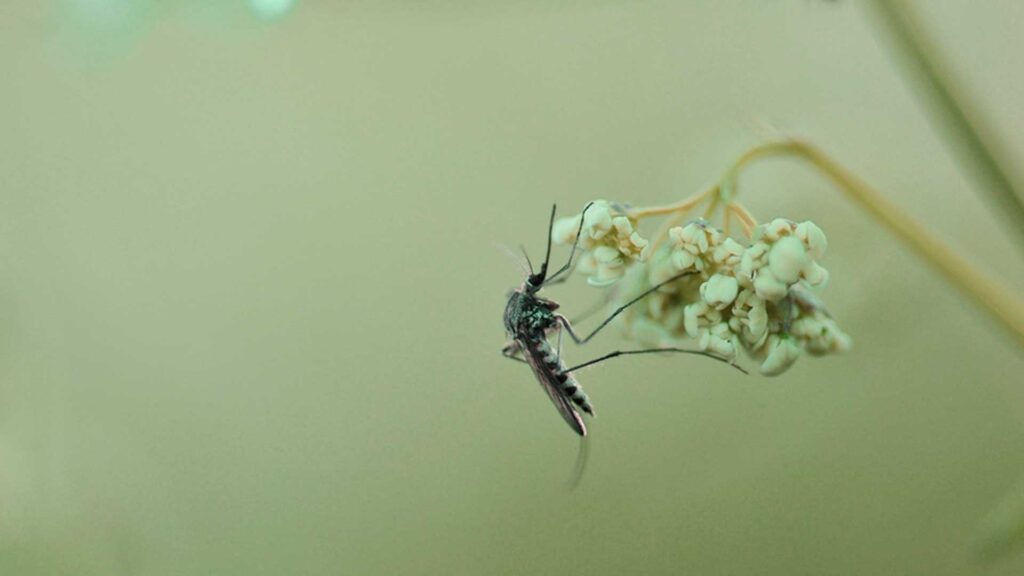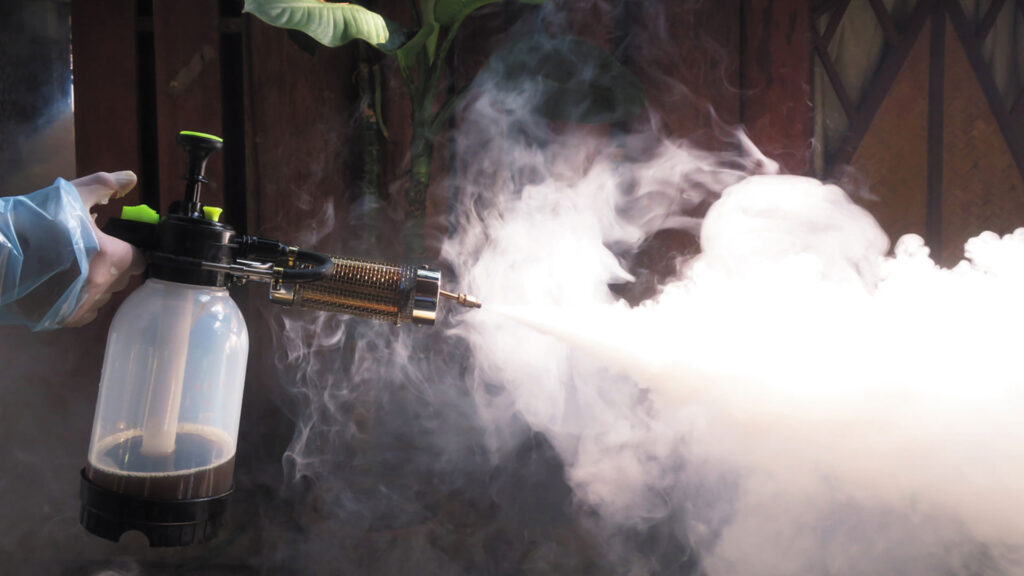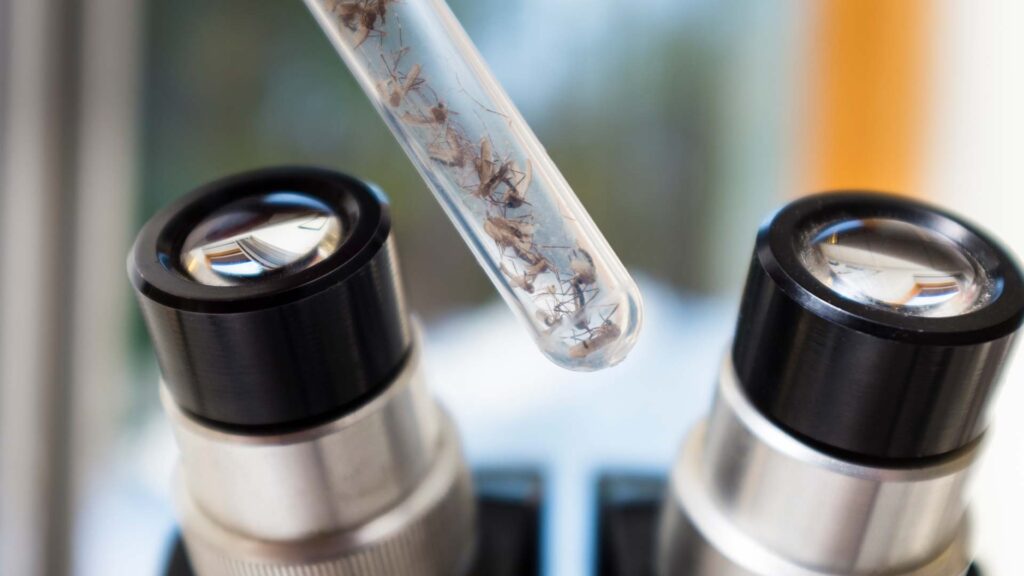Can Mosquitoes Bite Through Clothes?
Mosquitoes can bite through clothes, but their ability to do so depends on the thickness and weave of the fabric. Thinner, more loosely woven materials like linen and cotton are less effective at preventing bites. In contrast, thicker fabrics and tighter weaves offer better protection. Additionally, clothing treated with permethrin, a mosquito repellent, can significantly enhance protection against mosquito bites. While clothing can provide a barrier, it’s not entirely foolproof, and combining protective clothing with other measures like skin repellents and environmental controls is recommended for optimal protection.

In the tranquil comfort of our homes, we often overlook a silent adversary that lurks in our backyards, parks, and outdoor spaces. This adversary is the mosquito, an insect known not just for its irritating buzz and itchy bites, but more importantly, for its role as a vector for various diseases. Among the many questions that arise in the context of mosquito-borne threats, one stands out with particular relevance to everyday life: Can mosquitoes bite through clothes?
This query transcends mere curiosity, delving into the intersection of home safety and public health. Mosquitoes, responsible for transmitting diseases such as malaria, dengue, and Zika virus, pose a significant health risk worldwide. The ability of these insects to penetrate our first line of defense – our clothing – is not just a matter of physical discomfort but a critical factor in disease prevention and health safety.
Understanding the mechanics of a mosquito bite is essential. Female mosquitoes, the ones that bite, are equipped with a specialized mouthpart called a proboscis. This needle-like structure is designed to pierce skin and suck blood, which is required for egg production. The effectiveness of this biological tool against different types of clothing materials is a subject of scientific inquiry and practical concern.
The issue gains complexity when considering the diverse environments and lifestyles across the globe. In tropical and subtropical regions, where mosquito activity is high, the question of clothing as a protective barrier is of paramount importance. Here, the choice of attire can be a critical factor in daily life, influencing exposure to mosquito bites and the associated risks of disease.
Moreover, the topic touches on broader themes in public health and environmental science. It raises questions about the effectiveness of various preventive measures, from personal protection strategies to community-wide mosquito control efforts. It also invites a discussion on the innovations in textile technology and the development of clothing specifically designed to thwart these pests.
As we delve deeper into this topic, we aim to provide a comprehensive overview that blends scientific research, practical advice, and real-world implications. The goal is to equip homeowners and individuals with the knowledge and tools to protect themselves and their families from the hidden threat posed by mosquitoes, a threat that can sometimes penetrate as close as the very clothes we wear.
The Science Behind Mosquito Bites
Understanding the science behind mosquito bites is crucial in comprehending their potential threat to human health and safety. Mosquitoes, particularly female ones, are often vilified for their biting habits, but this behavior is rooted in a biological necessity rather than mere nuisance.
The primary tool for a mosquito’s bite is its proboscis, a sophisticated and highly specialized mouthpart. Unlike common perception, the proboscis isn’t a single needle-like structure but a complex assembly of parts. It includes two tubes: one to inject saliva, which contains anticoagulants and enzymes, and another to draw blood. This saliva is responsible for the itching and swelling that accompanies a mosquito bite.
Only female mosquitoes bite humans and animals. They require the protein found in blood to develop their eggs. This process is vital for their reproductive cycle. After a blood meal, a female mosquito can lay anywhere from a few dozen to over a hundred eggs, depending on the species.
Mosquitoes are equipped with highly sensitive chemical, visual, and heat sensors that guide them to their hosts. They can detect carbon dioxide exhaled by humans and animals from a considerable distance. Body heat and certain body odors also play a significant role in attracting mosquitoes.
When a mosquito lands on a potential host, it uses its proboscis to pierce the skin. The process is so delicate that it often goes unnoticed at first. The mosquito’s saliva, which prevents blood from clotting, triggers an immune response in the human body, leading to the characteristic itchiness.
The real concern with mosquito bites is their ability to transmit diseases. Mosquitoes can carry pathogens like viruses, bacteria, and parasites. When they bite, these pathogens can be transferred into the host’s bloodstream. Diseases such as malaria, dengue fever, Zika virus, and West Nile virus are all transmitted by mosquitoes, making them one of the deadliest animals on the planet in terms of human health impact.
Ongoing research is deepening our understanding of mosquito behavior and biology. Scientists are exploring innovative methods to control mosquito populations and prevent disease transmission, including genetic modification and new repellent technologies.
The science behind mosquito bites reveals a complex interplay of anatomy, sensory mechanisms, and biological needs. While their bites are often just a nuisance, the potential for disease transmission makes understanding and combating mosquitoes a significant public health challenge. As research advances, new strategies for prevention and control continue to emerge, offering hope in the fight against these pervasive pests.
Clothing as a Barrier: How Effective Is It?
The role of clothing as a barrier against mosquito bites is a topic of significant interest in the context of preventing mosquito-borne diseases. The effectiveness of clothing as a protective measure hinges on several factors, including fabric type, weave density, and coverage.
Research has shown that the type of fabric and its weave density are critical in determining the level of protection against mosquito bites. Thicker fabrics such as denim or canvas provide better protection compared to lighter materials like linen or cotton. The University of Florida conducted a study revealing that participants wearing thicker fabrics experienced fewer mosquito bites than those in thinner clothes. This is attributed to the difficulty mosquitoes face in penetrating dense fabric weaves with their proboscis.
The amount of skin covered by clothing is also a key factor. Long-sleeved shirts and long pants are more effective in preventing bites than short-sleeved tops and shorts. However, the fit of the clothing is equally important. Clothes that are loose-fitting may allow mosquitoes to bite through the gaps between the fabric and the skin, especially if the fabric is thin or loosely woven.
Essential Tips for Mosquito-Proof Clothing
- Choose the Right Fabric: Opt for tightly woven, thicker fabrics. Synthetic fibers like polyester or nylon are often more effective than cotton.
- Light Over Dark: Wear light-colored clothing. Mosquitoes are more attracted to dark colors, making you a more visible target.
- Cover Up: Long sleeves and long pants provide a physical barrier against mosquito bites.
- Treat Your Clothes: Consider using permethrin-treated clothing, especially if you’re in a high-risk area. This treatment can repel and kill mosquitoes.
- Layer Up: In areas with a high mosquito population, layering clothes can provide added protection.
The color of clothing can influence its effectiveness as a barrier. Mosquitoes are generally more attracted to dark colors, making light-colored clothing a better choice for reducing the risk of bites. Additionally, clothing treated with insect repellents like permethrin has been proven to enhance protection. Permethrin-treated clothing not only repels mosquitoes but can also be lethal to these insects upon contact, adding an extra layer of defense.
While clothing can be an effective barrier, it has its limitations. Mosquitoes may still bite through clothing if it is tight against the skin or if the fabric is thin. Areas where clothing fits snugly, such as around the ankles or wrists, can be particularly vulnerable. Moreover, clothing does not protect exposed skin, such as the face, neck, and hands, underscoring the need for additional protective measures like mosquito repellents.
While clothing can significantly reduce the risk of mosquito bites, its effectiveness depends on various factors including the type of fabric, weave density, coverage, and additional treatments. Homeowners and individuals in mosquito-prone areas should consider these factors when choosing clothing as a part of their strategy to prevent mosquito bites and related diseases. Combining protective clothing with other measures like repellents and environmental controls offers the most comprehensive defense against these persistent pests.
Understanding Mosquito Bite Prevention Through Clothing
| Factor | Description | Impact on Mosquito Bites | Practical Tips |
|---|---|---|---|
| Fabric Type | The material of the clothing. | Thicker fabrics like denim or tightly woven materials offer better protection. | Choose clothes made of dense or synthetic fabrics for outdoor activities. |
| Weave Density | The tightness of the fabric weave. | Tighter weaves make it harder for mosquitoes to penetrate. | Opt for garments with a high thread count or specially designed outdoor wear. |
| Color | The color of the clothing. | Dark colors attract mosquitoes more than light colors. | Wear light-colored clothing, especially in areas with high mosquito activity. |
| Coverage | The amount of skin covered by clothing. | More coverage means less exposed skin for mosquitoes to bite. | Wear long sleeves and pants; consider hats and socks for additional protection. |
| Treatment | Use of insect-repellent chemicals on clothing. | Permethrin-treated clothing can repel and kill mosquitoes. | Purchase pre-treated clothing or treat clothes with permethrin, especially for camping or hiking. |
| Fit | The style and fit of the clothing. | Loose-fitting clothes can provide gaps for mosquitoes to reach the skin. | Prefer snug-fitting clothes that leave less room for mosquitoes to find an opening. |
| Environmental Factors | The surrounding environment. | Mosquito activity varies with weather, time of day, and location. | Be extra cautious during dusk and dawn and in humid, tropical climates. |
| Complementary Measures | Additional protective actions. | Clothing alone may not be enough for complete protection. | Use mosquito repellents on exposed skin, install screens, and eliminate standing water. |
The Role of Color and Treatment in Mosquito Defense
The battle against mosquito bites extends beyond the material of clothing to include two less obvious but significant factors: the color of the fabric and its chemical treatment. These elements play a crucial role in either attracting or repelling mosquitoes, influencing the effectiveness of our daily wear as a protective barrier.
Mosquitoes, surprisingly, exhibit preferences for certain colors. Research has shown that these insects are more attracted to darker shades. A study published in the Journal of Medical Entomology revealed that mosquitoes tend to bite individuals wearing darker colors like black, navy blue, or red more frequently than those in lighter shades such as white or pastel colors. This preference is linked to the way mosquitoes use vision to locate their hosts. Dark colors stand out more during the dusk and dawn hours, the peak activity times for many mosquito species.
When it comes to treating clothing for added protection, permethrin emerges as a front-runner. Permethrin, a synthetic chemical, is a type of insecticide that is safe for human use and highly effective against mosquitoes. The CDC endorses permethrin-treated clothing as an additional layer of protection. This treatment works in two ways: it repels mosquitoes, reducing the likelihood of them landing on the treated fabric, and it can kill these insects upon contact.
Studies have demonstrated the effectiveness of permethrin-treated clothing. In one notable experiment, participants wearing treated gear experienced significantly fewer bites compared to those in untreated clothing. This finding is particularly relevant for individuals living in or traveling to areas with high mosquito populations or where mosquito-borne diseases are prevalent.
For homeowners, understanding the role of color and treatment in mosquito defense is key to making informed choices about their attire, especially during mosquito season. Opting for lighter-colored clothing can inherently reduce the attraction for mosquitoes. When engaging in outdoor activities, especially in wooded or wet areas, wearing permethrin-treated clothing can provide an additional layer of protection.
The implications of these findings extend beyond individual protection. By reducing the number of mosquito bites, the spread of mosquito-borne diseases can be mitigated. This is particularly crucial in regions where diseases like malaria, dengue, and Zika virus are a major public health concern.
The role of color and treatment in clothing is a vital yet often overlooked aspect of mosquito bite prevention. By combining these strategies with other protective measures, individuals can significantly reduce their risk of mosquito bites and contribute to broader efforts in controlling mosquito-borne diseases.
Practical Advice for Homeowners
For homeowners looking to minimize the risk of mosquito bites, a multi-faceted approach is key. Clothing choices are the first line of defense. Opt for long-sleeved shirts and long pants made from tightly woven fabrics, as these provide a physical barrier against mosquito bites. Light-colored clothing is preferable, as mosquitoes are more attracted to dark colors. Additionally, treating clothes with permethrin, an insect repellent, can significantly enhance protection. This treatment remains effective through multiple washes and is available in both spray and pre-treated clothing forms.
Beyond personal attire, homeowners should focus on their immediate environment. Regularly inspect and eliminate standing water sources around the home, such as in plant saucers, bird baths, and clogged gutters, as these are prime breeding grounds for mosquitoes. Installing screens on windows and doors and using mosquito nets, especially in sleeping areas, can effectively keep mosquitoes at bay. For outdoor spaces, consider using fans; the air movement makes it difficult for mosquitoes to fly and locate people. Additionally, planting mosquito-repellent plants like citronella, lavender, and marigolds can provide a natural deterrent.
- Opt for light-colored, tightly woven fabrics.
- Consider permethrin-treated clothing for outdoor activities.
- Use mosquito repellents on exposed skin.
- Implement environmental controls like screens and mosquito nets.
Incorporating these strategies into daily routines and home maintenance can significantly reduce the likelihood of mosquito bites, enhancing both comfort and safety for homeowners and their families.
Expanding the Horizon: Comprehensive Mosquito Control Strategies
In the broader context of mosquito control, community-wide efforts are as crucial as individual precautions. These strategies involve a multi-faceted approach, combining public health initiatives with environmental management. For instance, local governments often undertake regular monitoring and control of mosquito populations, employing tactics like larvicides in water bodies where mosquitoes breed. Additionally, public education campaigns play a pivotal role in raising awareness about the importance of eliminating standing water in residential areas, a common breeding ground for mosquitoes. Such initiatives not only reduce the mosquito population but also limit the spread of diseases like West Nile virus and Zika.
Another significant aspect of mosquito control is the use of biological methods and technological advancements. Introducing natural predators of mosquitoes, such as certain fish species in ponds, can effectively reduce mosquito larvae. Moreover, recent innovations, including genetically modified mosquitoes designed to decrease populations, and the use of drones for precision larvicide application, are emerging as promising tools in the fight against these pests. These approaches, when combined with traditional methods, offer a comprehensive strategy to manage mosquito populations effectively, thereby enhancing community health and safety.
Case Studies and Anecdotes
In examining the relationship between clothing and mosquito bites, several case studies offer insightful perspectives. A notable instance is a 2019 study in Southeast Asia, where researchers observed the biting habits of mosquitoes in rural and urban settings. They found that individuals wearing tightly woven fabrics experienced significantly fewer bites compared to those in loosely woven or thin materials. This study underscored the importance of fabric type in regions plagued by mosquito-borne illnesses like Zika and Chikungunya.
Anecdotal evidence further reinforces these findings. In regions of Africa where malaria is endemic, traditional clothing styles have evolved as a form of protection against mosquitoes. For example, in parts of West Africa, residents often wear long, flowing garments made from thick, brightly colored fabrics. These not only reflect cultural aesthetics but also serve a practical purpose in reducing mosquito bites. Personal stories from these communities highlight a noticeable difference in the frequency of bites and related illnesses when such traditional attire is worn, compared to Western-style clothing that often exposes more skin and is made of thinner materials. These real-world observations, while not scientifically rigorous, provide valuable insights into the effectiveness of clothing as a barrier against mosquito bites.
A Multifaceted Approach to Mosquito Protection
The battle against mosquito bites transcends the simple choice of clothing. While fabric type, color, and treatment are significant factors in deterring these pests, they form just one part of a broader, more comprehensive strategy necessary for effective protection.
Understanding that no single method offers complete protection is crucial. Mosquitoes, with their persistent nature and ability to transmit diseases like Zika, West Nile virus, and malaria, pose a complex challenge. This necessitates a multifaceted approach, combining personal, household, and community efforts.
For individuals, especially those in high-risk areas, the combination of protective clothing, repellents, and physical barriers like mosquito nets and window screens is essential. Clothing should be seen as the first line of defense, a physical barrier that can be enhanced with the right choices in material and treatment. However, exposed skin areas still require the application of EPA-approved repellents containing DEET, picaridin, or oil of lemon eucalyptus for added protection.
At the household level, homeowners can play a pivotal role in reducing mosquito populations. Regularly emptying standing water in pots, gutters, and birdbaths eliminates breeding grounds. Planting mosquito-repellent plants like citronella, lavender, and marigolds can provide a natural deterrent. Additionally, the use of mosquito traps and the installation of proper window and door screens can significantly reduce indoor exposure.
Community-wide efforts are equally important. Public health campaigns focusing on awareness and prevention can lead to collective action in maintaining clean, mosquito-free environments. Local governments and health organizations often spearhead efforts in larvicidal treatments in public water bodies and organize fumigation drives to control adult mosquito populations.
While clothing can provide a significant barrier against mosquito bites, it is part of a larger, more dynamic solution. The integration of personal protection measures, household practices, and community initiatives forms the cornerstone of effective mosquito control. As we continue to navigate the challenges posed by these vectors of disease, a holistic approach remains our best defense, safeguarding not just individual health but public health at large.
Frequently Asked Questions: Can Mosquitoes Bite Through Clothes?
Can mosquitoes actually bite through clothing?
Mosquitoes can bite through certain types of clothing, especially if the fabric is thin and fits loosely. The effectiveness of clothing as a barrier depends on the material’s thickness and weave.
What types of clothing are best to prevent mosquito bites?
Clothing made of tightly woven, thicker fabrics is more effective in preventing mosquito bites. Long-sleeved shirts and long pants made from such materials offer better protection.
Are mosquitoes attracted to certain colors of clothing?
Yes, mosquitoes tend to be more attracted to dark colors. Wearing light-colored clothing can help reduce their attraction.
Is there any treated clothing available that repels mosquitoes?
Clothing treated with permethrin, an insect repellent, is available and has been shown to be effective in repelling and even killing mosquitoes.
Can regular clothes be treated with mosquito repellent?
Yes, you can treat regular clothes with permethrin spray, which is available for consumer use. However, it’s important to follow the instructions carefully for effective and safe application.
Besides clothing, what other measures can I take to protect myself from mosquito bites?
Using mosquito repellents on exposed skin, installing screens on windows and doors, using mosquito nets, and eliminating standing water around your home can significantly reduce the risk of mosquito bites.
Are children more susceptible to mosquito bites through clothing?
Children can be more susceptible if they wear thinner, more loosely woven fabrics. It’s advisable to dress them in appropriate clothing and use child-safe mosquito repellents.
Can mosquitoes bite through jeans or other denim clothing?
It’s less likely for mosquitoes to bite through thick fabrics like denim, as the weave and material thickness provide a good barrier.
How effective are natural remedies compared to treated clothing?
While natural remedies can offer some protection, they are generally less effective than clothing treated with permethrin or other EPA-approved repellents.
Is it necessary to wear protective clothing indoors?
In areas with high mosquito activity, it can be beneficial to wear protective clothing indoors, especially if the living space is not well-sealed or lacks mosquito screens.




